
From shampoo to washing-up liquid, the body is exposed to a raft of foreign ingredients every day, many of which have the potential to do harm. Perhaps it’s time to take a less toxic route.
Have you ever wondered how many products you use daily? Let’s take a typical morning: body wash, toothpaste, mouthwash, body lotion, deodorant, make-up, handwash, hand cream, perfume – and that’s before you’ve even sat down to have breakfast. Let alone on a day when you wash your hair and add shampoo, conditioner and curl tamer or volume lifter to the mix. According to the Australian Academy of Science, the average woman uses 9-15 personal care products per day and when combined with the addition of perfumes, it is estimated that women place around 515 individual chemicals on their skin each day.
By constantly bombarding the body with products there is more of a chance that they will interfere with its natural functioning and increase the risk of health problems. However, this doesn’t mean everyone should panic and avoid the shower! But perhaps there is a cause to be more careful when it comes to choosing toiletries and to opt for solutions that reduce the amount of chemicals to which the body is exposed.
Here are five easy tips for leading a less toxic everyday life. If you want to feel detoxed from outside in, give them a go…
Choose natural personal care products
Be mindful when it comes to choosing personal care products by checking to make sure they contain naturally derived ingredients that are free from any chemical nasties (some lipsticks, for instance, contain lead) including parabens and phthalates. Choose products that contain natural and organic ingredients.
Protect your skin and airways when cleaning
Whether you’re using disinfectant spray, window cleaner or bleach, protect your skin by wearing gloves and open a window to let out any toxic fumes. Alternatively, choose eco-friendly brands that offer natural cleaning products derived from organic formulas.
Keep houseplants to reduce indoor air pollution
A paper published by NASA showed how houseplants such as peace lily (Spathiphyllum ‘Mauna Loa’), pothos or devil’s ivy (Chlorophytum Comosum) are a natural way of reducing indoor air pollution. Their presence has shown significant reductions in the levels of benzene found in synthetic fibres, plastics and tobacco smoke, as well as formaldehyde found in plywood, carpeting and household cleaners. If you don’t have time to visit your local garden centre, take a look online.
Be cautious with home fragrances
A study carried out by Professor Alistair Lewis of the National Centre for Atmospheric Science at the University of York found that limonene – used in air fresheners, scented candles and plug-ins to give a citrus smell – can be dangerous to inhale when it mixes with certain elements in the air. Be cautious about using too many home fragrances, try to make sure you open windows and maintain good ventilation throughout your home and keep a few of the houseplants mentioned previously.
Use free-from or low-volatile organic compound paint
Some paints contain heavy metals, formaldehyde and volatile organic compounds that release toxic emissions. If you can, buy either low-VOC paint or even VOC-free paint and remember to open windows and doors when decorating.
This article was originally published in Issue 9 – Live for the Moment



















